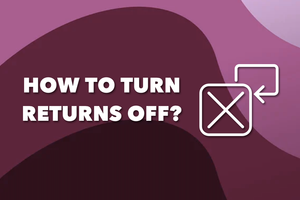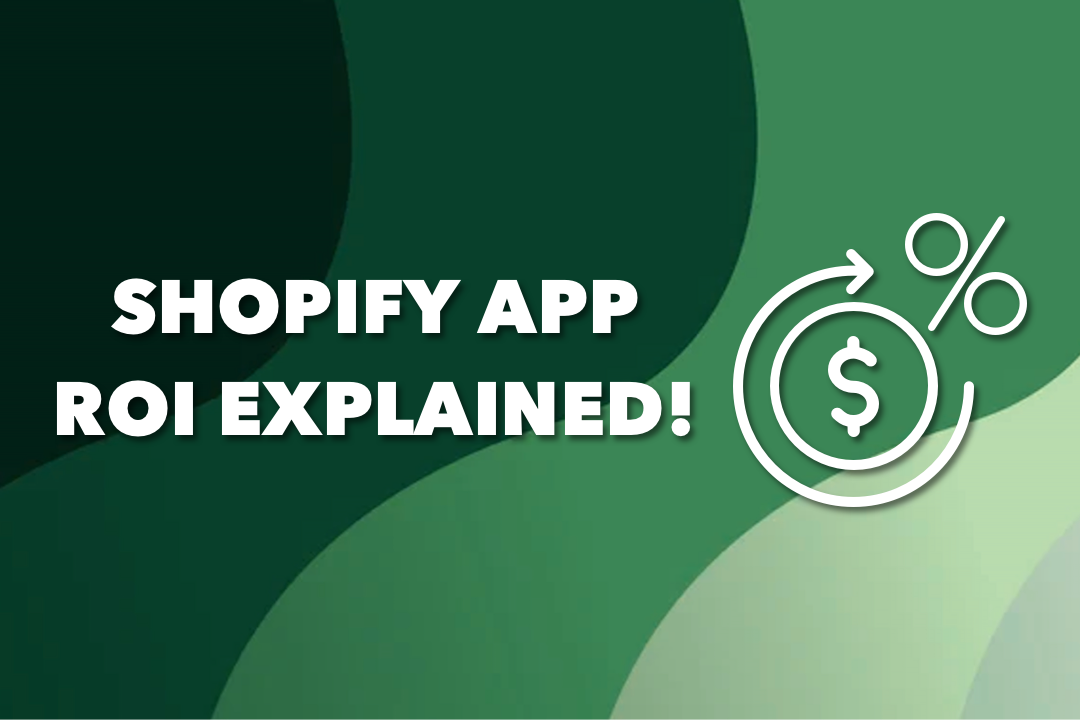
You have to know what works efficiently and what doesn't, for every part of your business. It is the key point to be aware of the strong and weak sides of your store, create strategies based on these points, make high-quality investments and achieve sustainable growth.
So, you should understand how to calculate the ROI of Shopify apps that you integrate into your store to understand which ones work efficiently and optimize your profit.
To help you in this case, in this article we explained what is ROI, why should you care about the ROI of Shopify apps & how to calculate it, and the best tips to improve the ROI of your Shopify apps. Let’s go!
What is ROI?
Return on investment is a key performance indicator that you can use to measure the profitability of investment by measuring the return on a particular investment, relative to the investment’s cost.

For instance, if your investment brings a $20 profit and if it has a $10 cost, you would have a 200% ROI.
By using ROI, you can compare the efficiency of your investment with different investments. So, you can understand how successful your business is and that is why it is crucial to be able to calculate the return on investment for any eCommerce store.
In other words, by measuring ROI for different parts of your business, you can understand which parts of your business need improvement and create effective strategies.
Why Should You Care About the ROI of Shopify Apps?
Calculating the ROI of Shopify apps has many advantages for your store. You need to calculate the ROI of the Shopify Apps you use in your store to understand whether they are efficient or not. It is the ultimate way to understand whether the Shopify app works in the way you want and whether it is worth it to pay that money.
If the results are not good, you may consider using alternative apps or using the money for a different kind of investment. By analyzing the data in the right way, you can understand what kind of alternative app could be the best decision for your Shopify store.
Besides, you can try different apps for a specific aim and understand which Shopify apps have better ROI. So, you can choose the best app for your investment aim. If one of the tools increases your revenue, you can spend more money and time on this app more confidently.

How to Calculate ROI of Shopify Apps?
Calculating the ROI of some Shopify apps is very easy since they provide the data of your profit clearly. However, it is not possible to calculate the ROI that easily for all Shopify apps. Here are the ways of calculating ROI for three kinds of Shopify apps:
1. If there is no data to calculate ROI: Some Shopify apps that you are using may not provide any kind of data that you can calculate the ROI with. In this case, implementing A/B tests to compare the value of the app is the most effective way to calculate ROI.
For instance, leveraging an A/B test is the only way to calculate the ROI of a UX app or a size chart app since there is no specific action that customers’ take about these apps. You should compare the revenue period while using the app with the revenue period while not using it. The crucial point when implementing A/B tests is keeping other factors the same.
2. If there are measurable actions happening with the app: If there are specific actions that customers take that you can measure, it is possible to measure the ROI.
For instance, if you are using a pop-up app for your Shopify store, you can measure the ROI by using the click rate of the pop-up. It won’t be a direct measure that shows profit but you can evaluate the efficiency of the app based on your purpose. ROI doesn't have to measure money all the time, it could also measure time or effort.
3. If you know how much revenue you earn: If there is data of how much money you spend on the Shopify app, and how much money you earned from the app, you can calculate your ROI easily with this formula below:
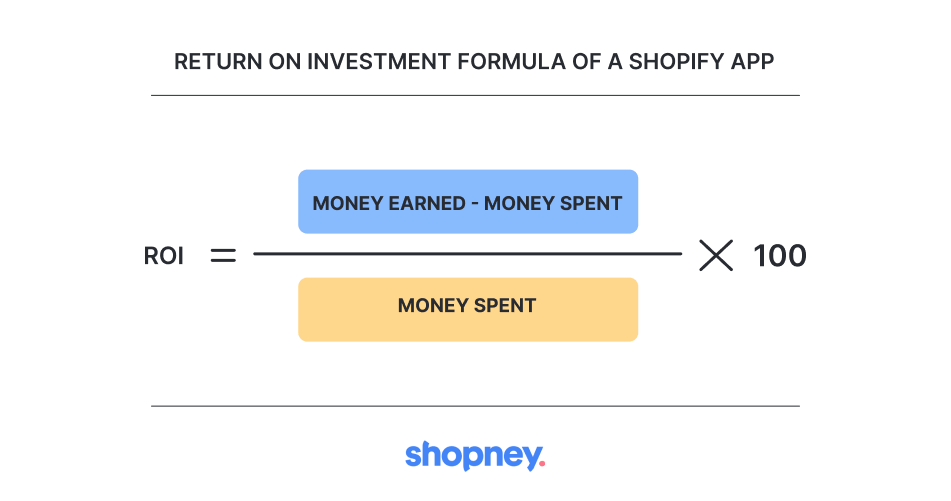
If the result is a positive number, it means you gained a return on your investment, but if it is a negative number, unfortunately, it means you lost money with your investment.
For instance, if you are using a loyalty marketing app, you can calculate the ROI by using the formula below:
This is a general formula that you can apply to any Shopify app. The crucial point here is that you should also consider other factors including time, hidden & additional costs, etc. All these factors may affect the ROI of Shopify apps.
On the other hand, you can calculate ROI of your mobile app easily since it provides all the data you need clearly.
How to Calculate ROI of Your Mobile App?
A mobile app is one of the most important sales channels of your Shopify store, so it is crucial that you understand its efficiency by measuring the ROI.
It is your responsibility to know about the efficiency of your sales channels, notice the problems and fix them by creating effective marketing strategies. You should know the net profit you earn from your mobile app.
Also, if you want to create sustainable growth in your mobile app, you have to know its ROI. Only in this way you can understand whether your business is growing and whether you need a more effective marketing strategy, etc.
Since mobile apps provide you numbers and data about your store and customers, it is so much easier to measure mobile app ROI compared to other Shopify apps. Here is how to calculate the return on investment of your mobile app:
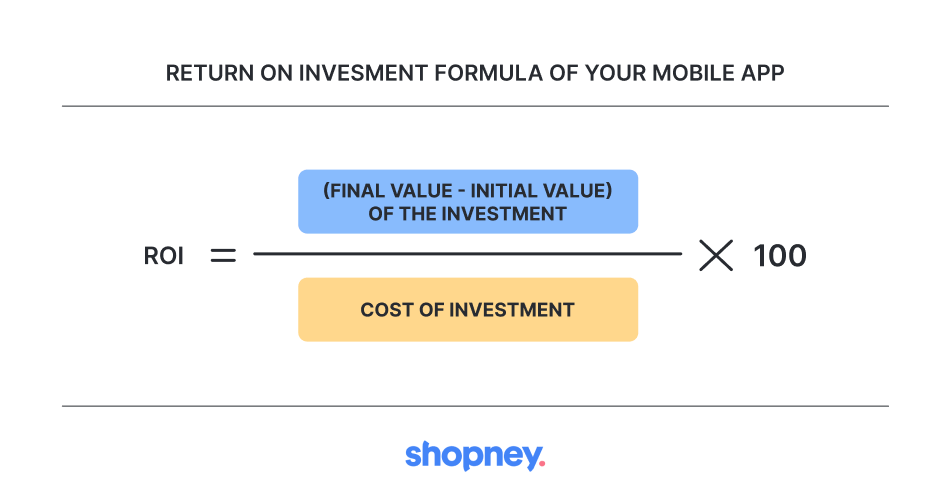
There are also other KPIs that you should consider while calculating your mobile app ROI. Ignoring these metrics could mislead you about your profit from the mobile app:
1. The Cost Per Install
CPI measures the cost of getting a user to download and install the app. It is generally used for mobile app ad campaigns. You can calculate the cost per install very easily by dividing the campaign budget by the number of new installs:
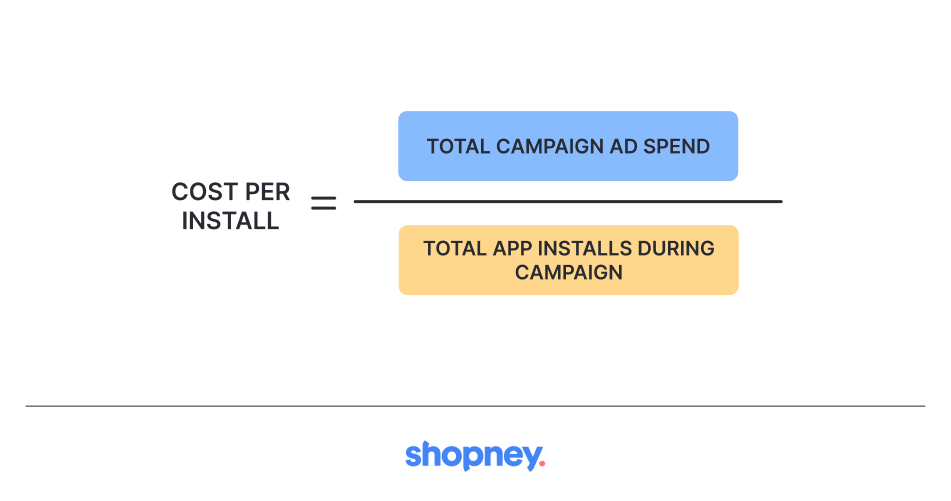
2. Lifetime Value
LTV is one of the most important metrics you should check to understand the ROI of your mobile app. By measuring the lifetime value, you can understand the long-term value of your mobile app. You can calculate the LTV with this formula:
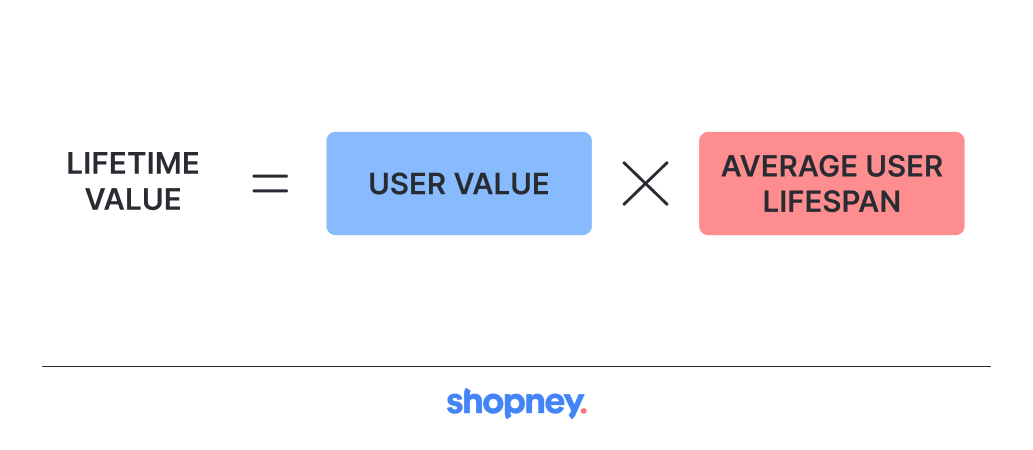
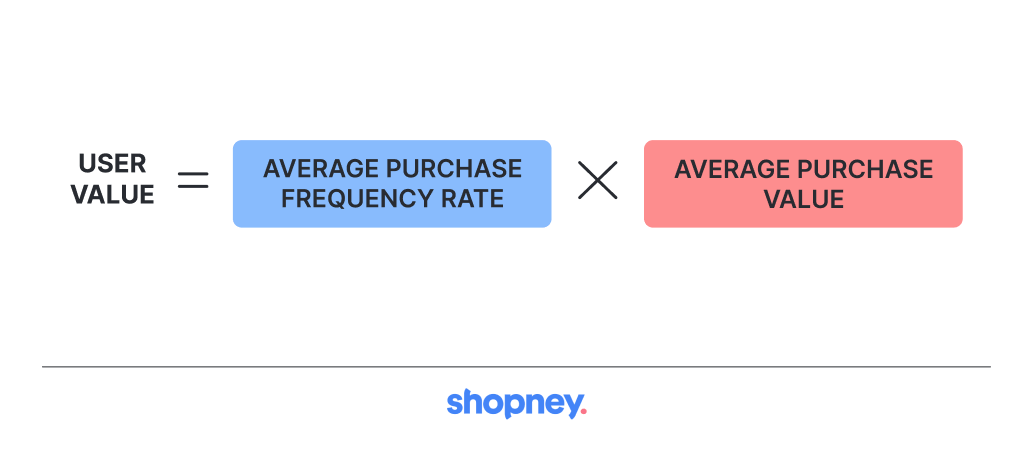
3. Average Revenue Per User
To calculate ARPU, you need to divide the app’s total revenue by the number of installs. For instance, if you earned $300 last month and had 9000 active users, your Average Revenue Per User would be $0.03.
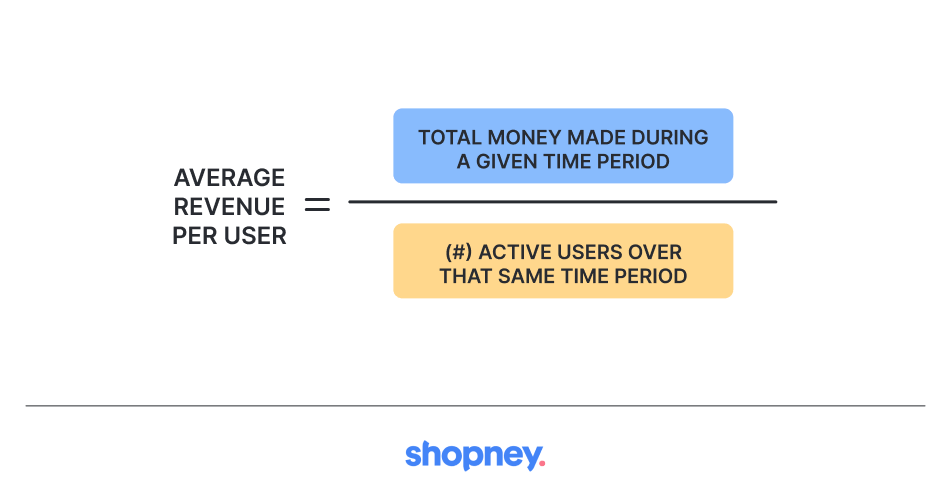
4. The Money You Saved by Leveraging Push Notifications
Besides boosting sales thanks to your mobile app, you can also save on your marketing ad spend by using push notifications.
Push notifications are the strongest marketing tool you have since you can send flash offers, limited drops, and product promotions directly to your customers' phones. So, you don't have to pay for expensive paid ads to bring your customers back to your store if you have a mobile app!
That is why while calculating the ROI of your mobile app, you should consider the marketing ad spend savings too. :)
What Actions You Can Take Considering the ROI Results?
1. Remove the Shopify App
If the measurement of the ROI is negative, it means the money you are paying for the app doesn't worth it. So, the most logical thing to do is cancelling the app.
The crucial point here is identifying the problems regarding the app and decide whether your business is proper for a this kind of app or not. For instance, if you don't get a lot of traffic to your Shopify store, you can't expect a good result from a loyalty app. That means you may not need this app and you should remove it without looking for an alternative.
2. Check the Alternative Shopify Apps
If the measurement of the ROI is not good enough for you, and if you think your Shopify store need this kind of a Shopify app, you can look for an alternative app to integrate your store.
For instance, if you are using Shopify Inbox, but you realize you need a Shopify customer service app that includes more features since you are growing, you may consider using Gorgias instead of Shopify Inbox.
If you are looking for alternative apps to boost your Shopify conversion, check our listing that includes the best Shopify apps to increase conversion.
3. Keep the Shopify App
After measuring the ROI of the Shopify app with the consideration of all the factors including time, hidden & additional costs, etc. if the result is positive and if it meets your expectations, you can keep the app.
Even if the result is good enough for you, there are always ways to improve ROI of a Shopify app and we listed the most effective ways below:
Best Tips to Improve ROI of Your Shopify Apps
Return on investment(ROI) is one of the key metrics to measure the profitability of the Shopify apps you integrated into your store. And, improving the ROI of these apps means increasing the profit of your business. That is why we have listed the most effective ways to increase the ROI of the Shopify apps you use. Let’s check them:
1.Analyze the Data of Shopify Apps
The first and simplest method to improve the ROI of these apps is increasing the revenue you gained from them. If you can increase the sales, or decrease the costs of these apps, you can have a higher ROI. And the ultimate way to create effective strategies to achieve that is by analyzing your Shopify store data regarding these apps.
By leveraging the data of Shopify apps, you can understand your customers' behaviors based on this app, create effective strategies and implement them in these apps to increase your revenue or decrease cost. You can improve your return on investment if you achieve to increase your sales and revenue without increasing your costs.
With your current return calculation and by identifying your customers’ shopping behavior, you can find the most appropriate methods to increase your sales & revenue and boost your ROI. The crucial point here is understanding your customer's needs, expectations and trying to meet them by utilizing these Shopify apps.
2. Reduce Costs of Shopify Apps
As we mentioned above, another effective way to increase the return on investment of your Shopify apps is by reducing its costs.
You can divide your costs regarding this app to understand how you can reduce them in the most logical way. Reducing fixed costs will have a positive effect on your business in the long term.
For instance, you might be paying for the highest plan of a Shopify app per month even though a lower plan is completely enough for your business. You can compare the pricing plans again and check which features you are actually using.
If you can decrease your costs, you wouldn’t have to increase your sales & revenue to have a higher ROI. As a significant point, while you are implementing these strategies you should be sure that they are not affecting customer satisfaction.
3. Check If the App Decreases Your Website Speed
Your website speed is the first impression of your brand for your customers. A low website speed means a high bounce rate and wasting all the effort that you make to bring the shoppers to your Shopify store.
If a Shopify app affects your website speed negatively, you may try to remove the redundant features and check again. If it won't be fixed you may consider removing the app.

4. Ask for Customers' Feedback
Customers' feedbacks are the greatest way to understand whether a Shopify app works efficiently or not. For instance, if you are utilizing a Shopify app for customer service & live chat, you can ask for feedback regarding the app after customers' experiences are over. So, you can understand whether your customers are satisfied with the app or not.
To Sum Up
As a Shopify business owner, you should know everything about your store including the efficiency of the Shopify apps you have integrated into your store. So, if there is an app that doesn’t work well, you can change it with a better one, or you may create new strategies to use it more effectively.
The ultimate way to understand whether a Shopify add-on is beneficial for your store is by measuring its ROI. So, you can compare the result of that integration with your expectations and check whether it works efficiently.
That is why in the above sections we explained how you can measure the ROI of Shopify apps and how to improve it in the most efficient way.
In addition, one of the greatest ways to improve the ROI of your Shopify store is to increase customer retention. And mobile apps are the most effective sales channels if you want to retain customers more. With a mobile app, you can turn your customers into more loyal ones.
That means turning your Shopify store into a mobile app is a very effective way to improve the ROI of your Shopify store. Shopney is the best Shopify mobile app builder and you can start your free trial today without any credit card information!


